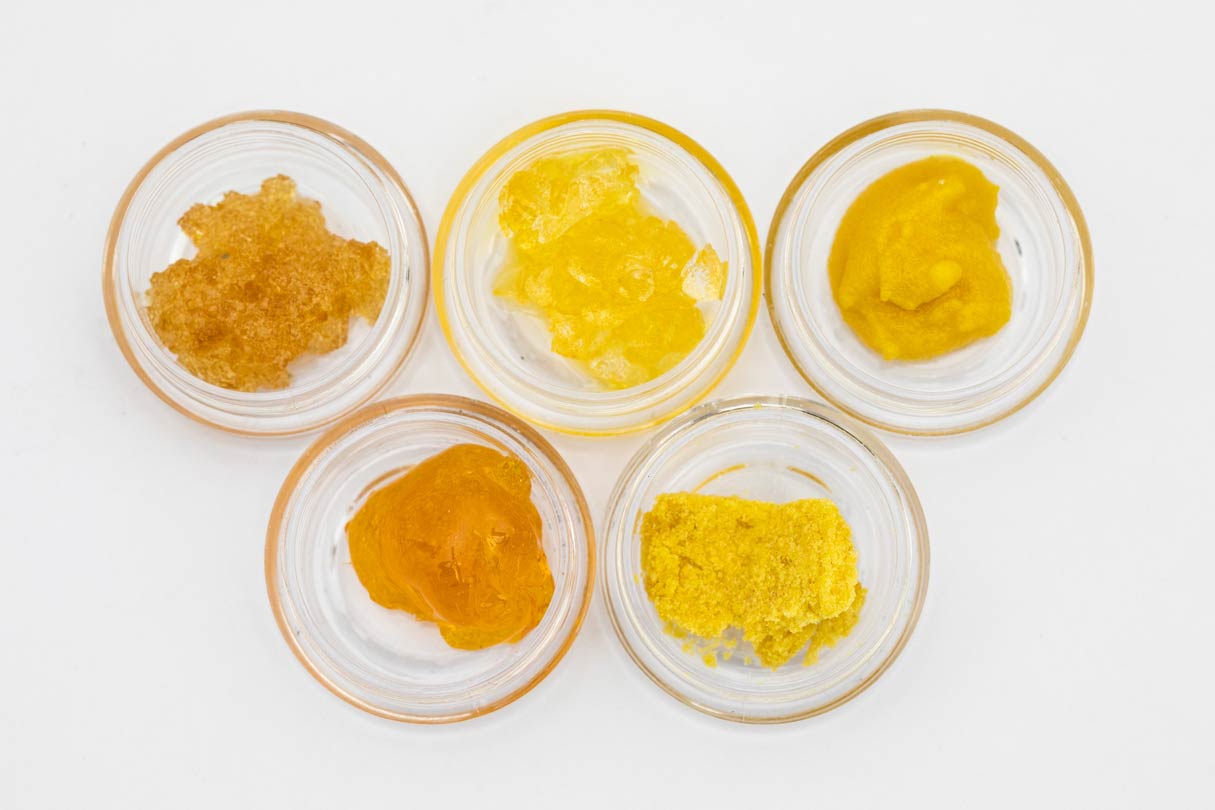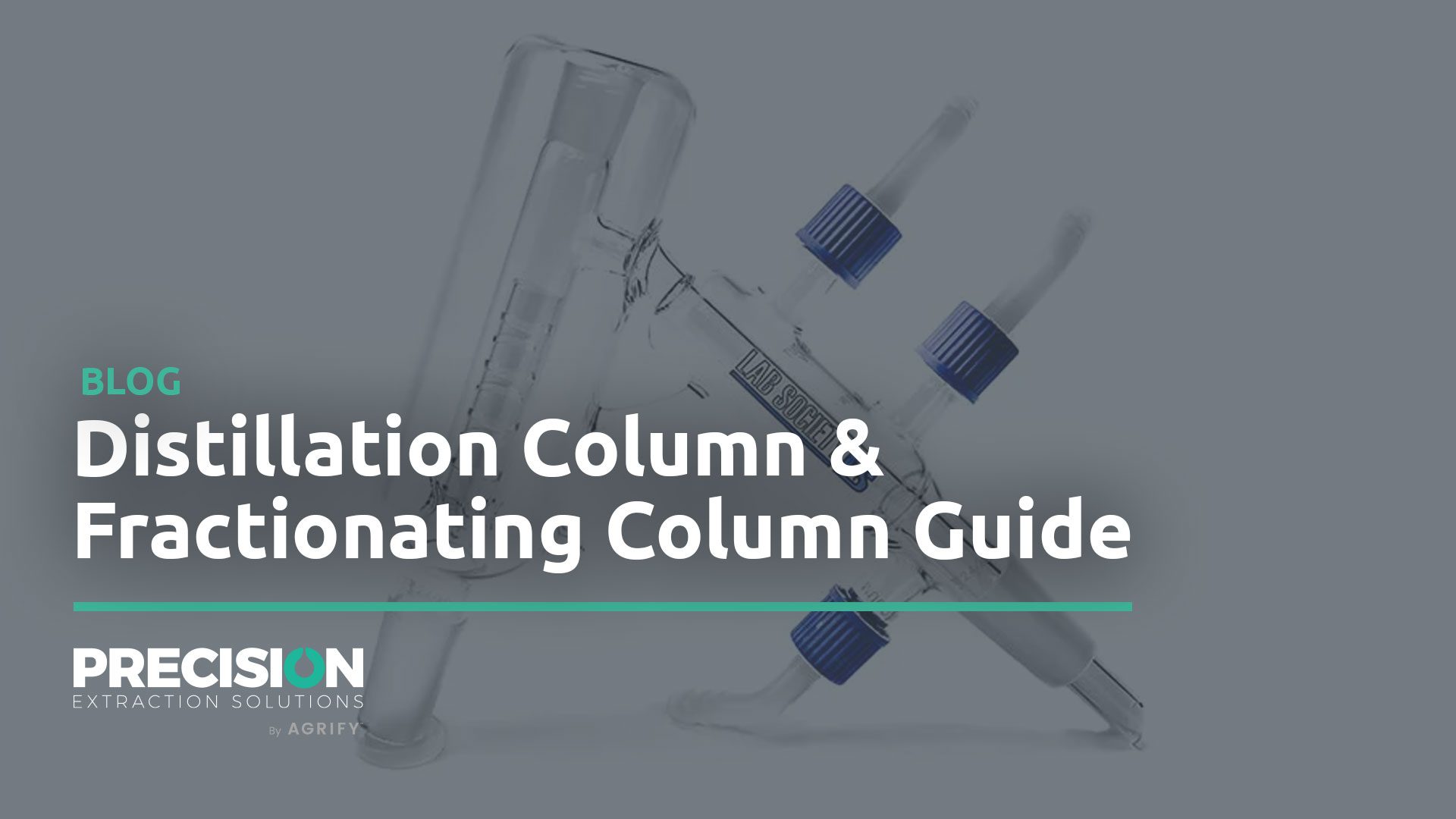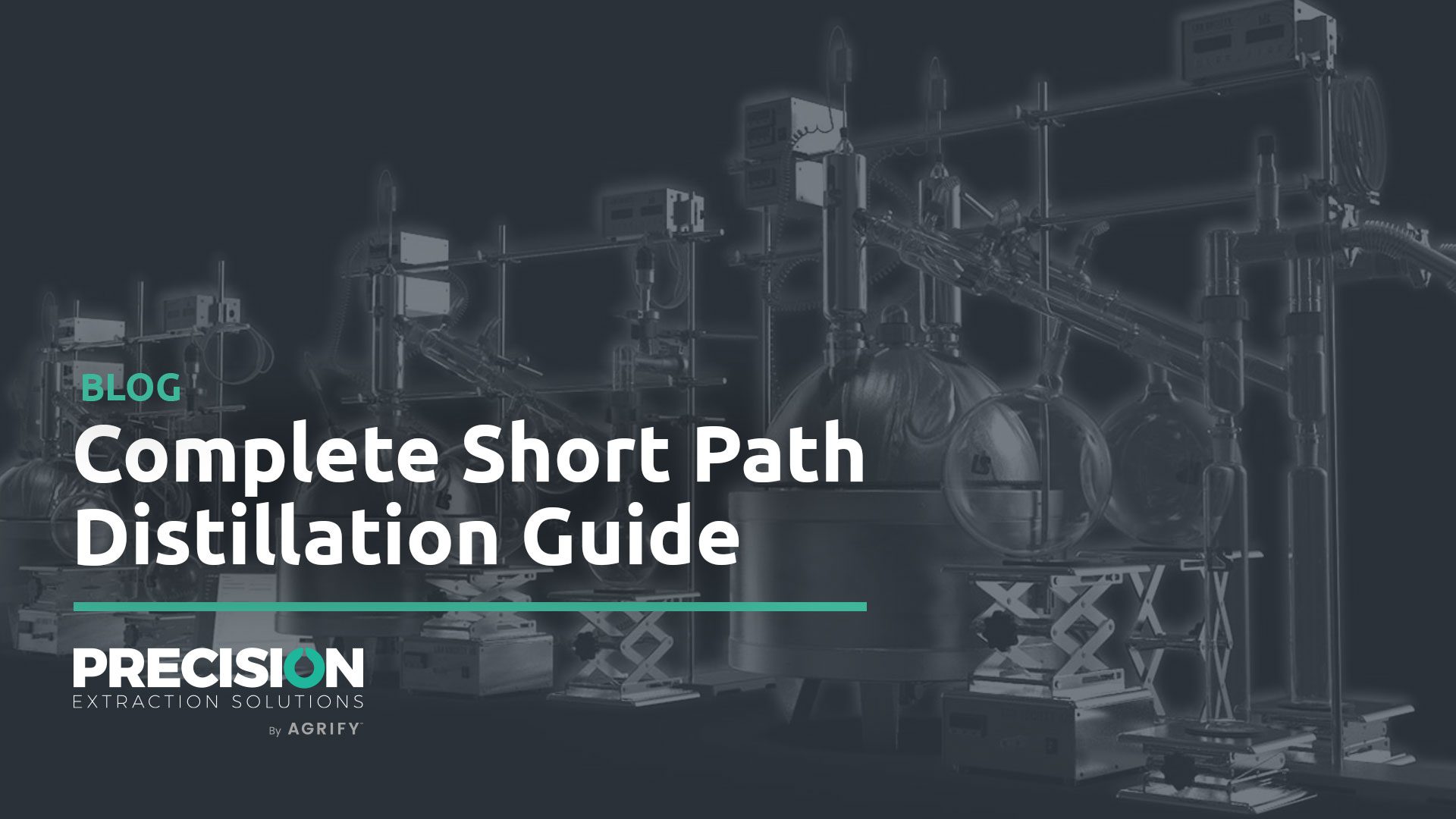
Fractional Distillation Defined (Fractionation)
Fractional distillation (or fractionation) is a powerful distillation technique that allows an experienced distiller to create highly purified products with less effort and shorter turnaround time than repeated simple distillations.
Fractionation can also perform separations that simple distillation cannot, such as isolation and recovery of multiple components in a single distillation.
In this article, we attempt to describe some of the technical details (as well as practical consequences) of the implementation of fractionation systems in an effort to produce highly purified botanical extracts.
History of Fractionation
While simple distillation has been practiced for many centuries, the modern continuous fractionation techniques were only developed in the 20th century.
Since then, it has become one of the most important purification processes; these techniques are practiced everywhere from small laboratory benchtops to large, industrial plants distilling several millions of gallons per day.
Both simple and fractional distillations can be implemented as batch or as continuous systems. Batch methods are typically used on smaller scale, laboratory-type preparations such as rotary evaporators, falling/rising film evaporators, or wiped/rolled film evaporators.
Compared to simple distillation, fractionation is carried out using two extra design elements, fractionation columns, and mechanisms to regulate the reflux.
If a significant part of the condensed vapor is constantly fed back into the system (called reflux) and comes into intimate and repeated contact with distilling vapors, this is called countercurrent distillation, also known as fractional distillation or more simply, fractionation.
Pictured to the right is an early continuous, fractional distillation apparatus for the production of purified ethanol. [ca. 1910]
Distillation Definitions [Types of Distillation]
Distillation is one of the most important separation and purification methods for liquid substances.
In the simplest case of distillation, a liquid is boiled by heating and the resulting vapor is cooled to condense as a distillate.
Note: Only one phase, the vapor, is moving in this scenario. It is possible to achieve high levels of purity, but only in relatively simple cases. As a guideline, binary mixtures with a boiling point difference of more than 25°C can be separated reasonably well by a skilled distiller.
Continuous distillations are standard processes in the chemical industry. One of the biggest and most visible examples is crude oil refining, where thousands of barrels of crude oil per hour are fed into a refinery.
Corresponding volumes of products with differing boiling point ranges (butane, kerosene, gasoline, diesel, jet fuel, etc.) are discharged and shipped out at the other end. Another natural product, fatty acids are also refined on a large, industrial-scale by vacuum fractionation.
While these everyday products may seem simple enough, keep in mind that refineries are multi-billion dollar chemical factories and require teams of chemical engineers to spend enormous amounts of time on their design, implementation, and maintenance.
Pictured below is a schematic of a contemporary crude oil distillation column highlighting multiple component isolation.
The Science and Engineering Behind Fractional Distillation
First, a few more definitions that are instrumental in understanding the mechanics:
Isothermal:
“At the same temperature”, i.e. in an environment where the temperature is kept constant.
Within this context, this refers to an effort to insulate the column from external thermal effects that could potentially disrupt the vapor-liquid equilibrium.
Frequently, columns come equipped with a vacuum jacket or other insulation to allow for high-temperature fractionations, where uncontrolled cooling from ambient air is most unwanted.
Vapor Pressure
This is defined as the pressure created by a vapor in equilibrium with its liquid phase at a given temperature in a closed system, such as a distillation apparatus.
Once this pressure rises to the same level as the ambient pressure in the system, bubbles are stable in the liquid, and it will start to boil.
Keep in mind that liquid doesn’t have to boil to evaporate. Lower boiling point solvents – such as pentane or hexane – have noticeable vapor pressure.
When left in an open flask or beaker, they can “disappear” within an hour or less.
This becomes obvious when you’re opening your gas tank to fill up on a hot summer day: You’ll hear some hissing as gasoline vapors escape.
Needless to say, most solvent vapors are highly dangerous in a mixture with air, and they present a potential fire or explosion hazard.
Partial Vapor Pressure
In a non-ideal mixture of many compounds, each compound contributes a fraction (hence “fractional distillation”) of the total vapor pressure in accordance with their respective boiling points.
Imagine a blend of pentanes and hexane, as in the industrial solvent petroleum ether: The lowest boiling ingredient, typically iso-pentane, boils at 28°C or ~82°F. As long as it is not completely removed from the blend, it will contribute greatly to the total vapor pressure.
The highest boiling component, typically n-hexane, boils at 69°C, or ~156°F. While the vapor will always contain a small fraction of n-hexane, it will remain relatively small until it is enriched enough in the blend that it represents a major fraction of the substance.
Other compounds with boiling points in between behave accordingly.
Theoretical Plate
A theoretical plate is an area in the column where the recondensing liquid and the rising vapor come into equilibrium with one another.
This applies to a packed column vs. one with actual, physical plates or trays.
The Height Equivalent to the Theoretical Plate (HETP) is the distance (length) between theoretical plates, and it is a measure of separation power in such systems.
The longer the column is (or the more plates it has), the better your separations will be.
Simple distillation systems have, by definition, one theoretical plate at best, possibly even less when not run optimally.
Similarly, this also applies to physical plate/tray columns – e.g. one practical plate typically has 90% or so of the separation power of a theoretical plate in an ideal case.
On the other hand, well-designed and run systems can have 100 or more theoretical plates.
These come most often in the form of spinning band or packed columns (see the implementation section below) and can purify compounds up to 99.9% or better depending on the difference in boiling points. This diagram shows the purification power vs. the number of trays in a practical environment.
Pressure Drop
This is primarily relevant in vacuum fractionation or fractional distillation. In this context, ‘pressure drop’ refers to the difference in pressure between the boiling flask and the head of the column.
The difference in pressure is caused by the gas flow resistance that the column represents. So, regardless of the performance of the vacuum pump, a given distillation design in a particular distillation application has inherent limits due to its gas flow characteristics.
Depending on system design and operating conditions, this can be fairly high – as in multiple millimeters of mercury.
Note that the vacuum in the boiling flask can’t be lower than this pressure drop. Normally, this isn’t a problem and the distiller just raises the temperature accordingly. However, temperature-sensitive compounds may not survive or suffer in quality.
Since raising temperature may not be an option, only columns with a small pressure drop should be applied in these cases.
Reflux Ratio
The amount of condensed distillate allowed to flow back into the system relative to the amount of distillate collected.
Practical reflux ratios are typically between 5:1 to 25:1. In other words, only between 4-20% is taken off into the receiver, while the rest flows back into the column.
A higher ratio typically improves separation power.
Holdup
The “dead volume” in a column during operation, or the amount of liquid that is held on the trays or in the packing.
Since this material can’t be distilled over, it is desirable to keep this as small as possible in a column design. Packed and tray columns typically have a much higher holdup than Vigreux or Spinning Band columns.
Simple vs. Fractional Distillation – The Details
As mentioned above, the difference in boiling points is the most important discriminator for fractionations.
One might tend to think, that the compounds in the mix going in are going to come out, purified to 99.9% or better, one-by-one, according to their boiling points.
Unfortunately, the reality is quite a bit different from this ideal.
This chapter will attempt to describe the physical reality without going too deep into the math involved.
Of course, the materials used in this industry are not simple binary mixtures and are far from being “ideal” in the physical sense.
However, by and large, the basic physics still apply.
As has been observed by early scientists, the partial vapor pressure of each compound determines both order as well as purity of the fractions coming out of the apparatus, the nature of which also has a major influence on the outcome (i.e. purity of the fractions).
In a simple distillation of a binary mix (with components L and H) with different boiling points, on heating, the mixture will come to a boil (at a temperature between those points).
At that point, the vapor contains a higher fraction of the lower-boiling compound L. However, this ratio changes over time due to the mix in the boiling flask getting depleted of L. The temperature of the liquid will also rise towards the boiling point of H in the course of the distillation.
Also, the vapor created gets richer in H until, towards the end, almost pure H gets distilled over.
Conversely, in fractional distillation (again, with a binary mix as above) the vapor gets condensed and re-evaporated multiple times across the length of the column, due to the feedback of liquid in an amount fitting to maintain intimate contact and creation of an equilibrium between vapor rising and liquid flowing back.
This has (approximately) the same effect as multiple simple sequential distillations in one operation, i.e. yielding a (much) purer product.
However, the cost of this is twofold:
One is obvious, increased equipment cost and operational complexity. The other one is increased operation time, due to the reflux factor, which allows only a relatively small fraction of the distillate to be taken off (practically, 20% or less).
This is a necessary compromise between the duration of the operation and efficiency of the operation, i.e. fraction purity.
The higher the reflux ratio, the better the column separation power (up to the theoretical design limits).
Various Implementations of Fractionation Columns

Here’s an overview of popular fractional distillation columns and general characteristics:
| Pressure Drop | Separation Power | Cost | |
|---|---|---|---|
Vigreux |
very low | low | low |
Packed Columns |
high | high | medium |
Tray Columns |
high | medium | high |
Structured Columns |
medium | high | high |
Spinning Band Column |
low | very high | very high |
Vigreux Column
A Vigreux column typically is a straight tube with many, regular indentations. These indentations are meant to create slowdowns for the vapor flow, to promote liquid-vapor exchange.
While this technique works in practice, the separation power isn’t very good.
The advantages of aVigreux Columns are that they are low cost and very low-pressure drop, due to their similarity to an empty tube.
They work best in very low-pressure separations.
Tray or Plate Columns
These are glass tubes with ~5-30 perforated trays and a flow-back pipe assembled by skilled glassblowers, in various sizes.
Large variants typically cost thousands of dollars, but they have good separation power and low-pressure drop.
Packed Columns
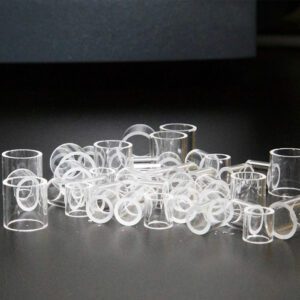
These are simple tubes with bottom support for the packing.
A wide variety of such packings exist, with equally widely varying cost and performance characteristics.
The packing material gets “poured” into the column, like a viscous liquid (this is the reason the name “random packing” is frequently encountered in literature).
Low-cost packings are often glass beads, Raschig Rings, Berl-saddles, etc.
Amateurs have also claimed success in fractional distillation using crushed beer bottles or scrub pads; however, their results haven’t been well measured or documented.
On the other end of the spectrum, the best possible HETP can be achieved with high-efficiency packings. An HETP of less than 20 mm is achievable with these, and hence the equivalent of 50 trays or more with a 150 cm (~5 ft.) long column (depending on operating conditions).
Structured Columns
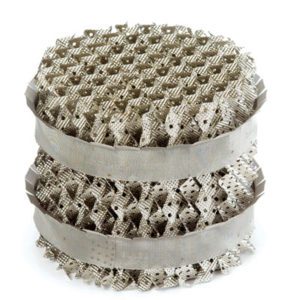 These are sort of pre-packed columns with highly engineered and pre-manufactured column fillings, that perform as well as (or better than) high-efficiency loose packing or similar, with a lower pressure drop and high throughput.
These are sort of pre-packed columns with highly engineered and pre-manufactured column fillings, that perform as well as (or better than) high-efficiency loose packing or similar, with a lower pressure drop and high throughput.
However, they’re mostly used in larger production or industrial installations, but rarely in a lab or small production context, and are accordingly quite expensive.
Spinning Band Columns
As the name suggests, the central element is a rotating band, most often made of Perfluoroalkoxy Polymer (PFA), spinning at high RPMs. This forces an intense exchange between liquid and vapor, at the same time keeping the pressure drop to a minimum.
These columns are well known as high-end separation systems. While large systems are uncommon, existing commercial implementations have several kg/hr. throughput with a comparatively high cost.
Fractional Distillation/Still Heads – (or Liquid Dividers or Reflux Controllers)
As mentioned earlier, the liquid arriving at the upper end of the column needs to be partitioned into a reflux portion and a take-off portion to maintain a compromise between high production rate and high purity.
Typically, depending on system, throughput and purity requirements, a reflux rate of 80-95% is recommended.
While all these numbers can be simulated and calculated in advance (as in the case of refineries or similarly large installations), in practice, it is often easier and cheaper to run practical tests.
Reflux regulation can be arranged via numerous designs, either manually or automatically. Some systems even allow computer control and monitoring.
The picture shows a standard design in use in lab fractionations.
An experienced distiller can assemble and run a capable system from parts alone, however, offers turn-key systems for many of the most common scenarios, designed to suit varying levels of user expertise and desired performance/output.
Fractional Distillation Receiver
While these are also elements of simple distillation systems, they require a higher level of sophistication to allow for separate capturing of the various fractions coming in.
A “cow” may be sufficient if only a few fractions are present; however, they are limited to 3 or 4 receiving flasks.
a “cow” or Multi Distribution Adapter is shown in the illustration on the right.
Azeotropes (Azeotropic Distillation)
As a side note, some mixtures can not be separated by simple or fractional distillation.
These are called azeotropes.
96% ethanol is one well-known example.|
However, methods exist to break these mixtures up, through either chemical means (in this case with drying agents) or through “trickery”, i.e. moving the azeotrope into a pressure/temperature combination where it no longer exists, or by using another material that forms a different, lower-boiling azeotrope that is capable of having a component removed.
For instance, benzene used to be a popular material to produce technical anhydrous ethanol.
Further Suggested Reading on Fractional Distillation
- Kirk-Othmer, Encyclopedia of Chemical Technology (chapter Distillation)
- Perry’s Chemical Engineers’ Handbook, chapter XIII
